This kimono represents a fascinating convergence of traditional Japanese motifs with the bold graphic sensibilities that would later influence Art Deco design, creating a textile that feels both timelessly elegant and distinctly modern. Set against a rich burgundy rinzu damask background, the composition features meticulously rendered origami cranes (tsuru) in soft pink and vibrant green, interspersed with golden stylized clouds that float across the silk surface in organic, irregular shapes. The silkscreen technique allows for precise registration of these complex multi-colored motifs while maintaining the crisp geometric faceting that gives each paper crane its distinctive three-dimensional quality, demonstrating the period's advanced technical capabilities in textile production.
The symbolic resonance of this design is particularly profound within Japanese cultural context—cranes represent longevity, good fortune, and peace, while their association with origami connects them to themes of transformation and the beauty found in careful, meditative craftsmanship. The golden clouds (kumo) traditionally symbolize divine favor and the ephemeral nature of earthly concerns, creating a composition that suggests both celebration and contemplation. The interplay between the angular, geometric precision of the folded paper forms and the soft, organic shapes of the clouds demonstrates the Japanese aesthetic principle of finding harmony in contrasts, while the rich color palette of burgundy, gold, pink, and green creates a sense of luxurious abundance.
This kimono embodies the cultural confidence of the Taishō era, when Japanese designers were successfully synthesizing traditional iconography with increasingly sophisticated production techniques and contemporary color theories. The overall effect anticipates elements that would later appear in Western decorative arts movements, particularly in its bold use of contrasting colors and its celebration of geometric abstraction, positioning this piece as both a masterwork of traditional Japanese textile art and a harbinger of international modernist design principles.
It measures 46 inches (117 cm) from sleeve-end to sleeve-end, standing at 57 inches (145 cm) tall.
.avif)











